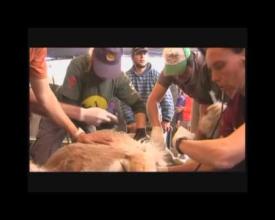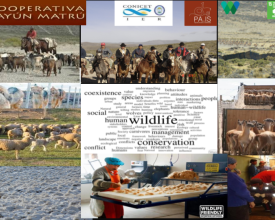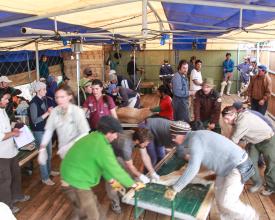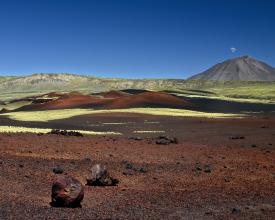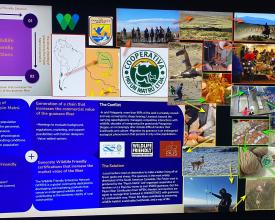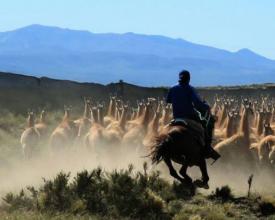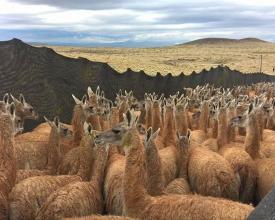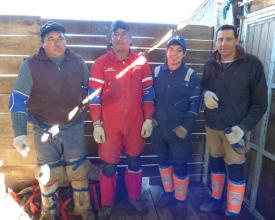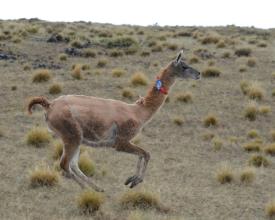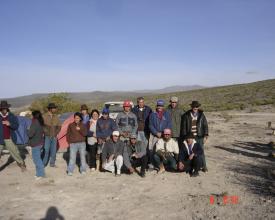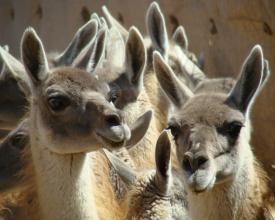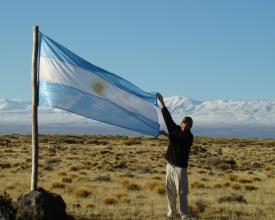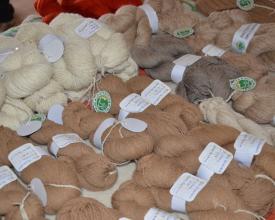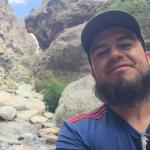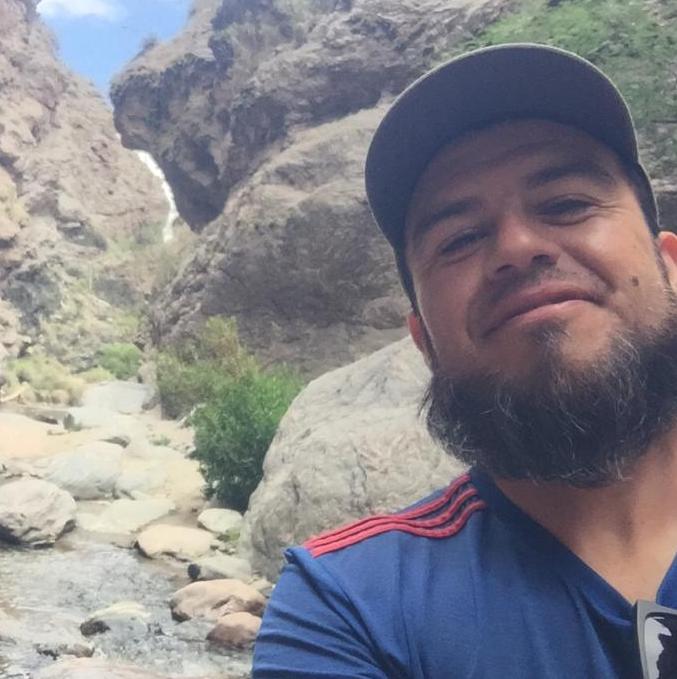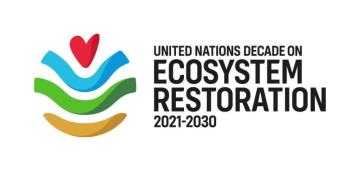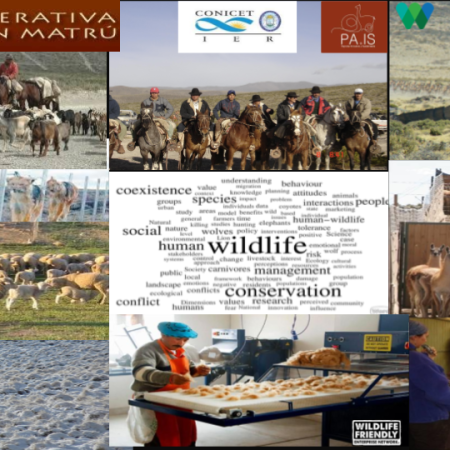
Wildlife Friendly Patagonian Fiber: Building capacity for sustainability of guanaco use.
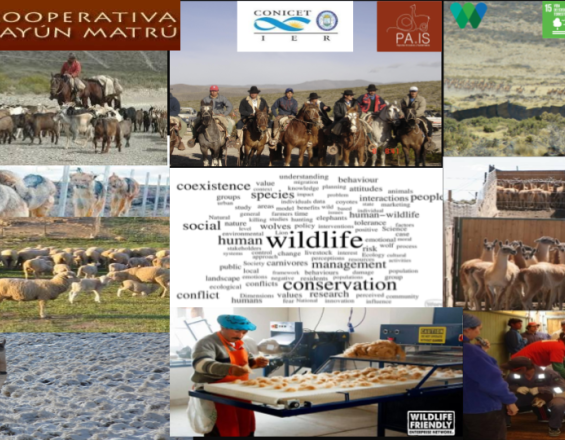
"Why? We must think on Wildlife "Friendly" Actions (WFA)"
The purpose of this solution is to highlight and expand the importance of the sustainable use of guanaco fiber due to the potential of this activity to generate local socio-economic development and become an effective conservation tool reducing the impact of the human footprint. To achieve this, we propose to 1) Promote the sustainable use of wild guanaco populations through demonstrative experiences of live-shearing in La Payunia Reserve; 2) Encourage the generation of a chain that increases the commercial value of the guanaco fiber by linking primary production sectors with the national and international textile sector; 3) Generate WFA certifications that increase the market value of the fiber, and 4) Encourage WFA actions through effective communication strategies giving visibility to the sustainable management of wild guanacos. “We believe in the power of consumers to change the Land-use paradigms”
Context
Challenges addressed
100 years of sheep farming in Patagonia led to human intolerance of guanacos, which combined with illegal hunting, has decimated wildlife populations across protected areas. Our project completed targets in 1)biodiversity conservation, by increasing the abundance and viability to one of the few existing populations that continue to exhibit annual long-distance migrations, recovery their functional role, and change the negative perception by local people for a positive one. 2)Land management, by reducing the process of desertification of arid ecosystem because livestock is poorly managed and stocked at densities beyond the carrying capacity of the range. 3) Social Solution, by building a unique textile center in the region (inside la Payunia), generating local labor, and avoiding the emigration of young people to urban centers.
Location
Process
Summary of the process
The four blocks (B1, B2, B3, B4) must work in a "bottom-up" relationship, the first (and most important) step is to obtain the raw material, the wool. The orange lines are the first steps to complete in B1, the green lines are the steps to complete in B2, the yellow lines are the steps to complete in B3 (we must meet the WFEN requirements of social and ecological sustainability, population viability of the species under management).
Building Blocks
Promote sustainable use of wild guanaco populations through demonstrative experiences of live shearing in La Payunia.
The annual shearing of guanacos by the Payún Matrú Cooperative is being closely supervised by the Mendoza Department of Renewable Natural Resources to ensure that the potential economic income provided by guanaco wool is feasible and sustainable. At the same time, Cooperative members understand that by making "good practices" they receive "good benefits". CONICET has tested and developed methods for minimizing the stress of individual guanacos during capture and handling, that reduce negative impacts at the population level. Our knowledge of ecological, physiological, and behavioral processes that "constrain" these camelids in La Payunia, based on more than 10 years of study, put us in a unique position for advising and teaching the cooperative and government stakeholders how to minimize impacts of live shearing on this population. We will continue training members of Payún Matrú Cooperative in "good practices" to make capture and shearing of wild guanacos within Wildlife Friendly Actions. The following activities will be carried out at this stage:
Enabling factors
1)Pre-shearing surveys on population parameters, 2)Training of the personnel (without experience) in charge of guanacos handling during herding, within the corrals, and during shearing is key to the success of the activities. 3)Management of wild guanacos: Capture, shear, and release of wild guanacos will be carried out in two events, between September and November. 4)Physiological indicators: physiological stress in the function of handling conditions.5)Post-shearing surveys on population parameters such as social structure and population density.
Lesson learned
-As we are working with wildlife, pre-shearing surveys on population parameters help us to select the best area to build the management structure.
-Training of the personnel is fundamental (and the key for the success of this solution) for the good management of the animals, avoiding guanaco mortalities and operator injuries. The management of wild guanacos is different from any other domestic animal, and it is necessary to use particular structures and tools, as well as to learn specific maneuvers for their manipulation, keeping animal welfare in mind.
-Stress approach give us a key physiological indicator to reduce stress in relation to handling time.
-Post-shearing surveys give us key population parameters such as social structure and population allow us to compared with data before the live-shearing experience and define the impact on social disruption.
Encourage the generation of a chain that increases the commercial value of the guanaco fiber by linking the primary production sectors with the national and international textile sectors.
Work with different actors at the local, national, and international levels, to contribute to the design of a fiber value chain that can trigger the activity. The work will consist of the identification of key public and private actors in order to provide tools for the commercialization of the product. The activities that will be developed in this stage of the project include meetings with the textile sector, application authorities, and various important local actors in this area.
Enabling factors
-Meetings with representatives of national organizations to evaluate background, regulations, marketing, and support possibilities for wild guanaco management experiences.
-Meetings with selected fashion designers at the national (i.e Buenos Aires) or international (i.e Canada) scale, to generate a fair value chain and promote WFA experience.
-Value-added options will be identified at the national/international level through meetings with actors from the public and private sectors, to expand WFA as a “Based nature Solution".
Lesson learned
Wildlife camelid management actions began in the 80s, based on the philosophy of the "ICDPs", seeking to link biodiversity conservation with improving the life quality of life of local people. These projects, which initially focused on the vicuña, were based on the application of economic incentives to promote the use of wildlife. We prove that wild guanaco use could improve the numbers of those initiatives because of the wider distribution range of the species. In Argentina, the production of SAC fiber could easily double due to an increase in the number of sheared populations and an increase in the frequency of shearing. This would clearly lead to a change in the production paradigm in contrast to the current one. Guanaco fiber is amongst.The Cooperative decided to add value to the raw fiber in order to increase the value. By 2010, most of the projects had stopped due to difficulty in marketing guanaco fiber with a price of USD $40-60 per kilo. The "problem" is there are only two trade companies that buy raw fiber that is exported mainly to Italy and control the market prices.
Generate wildlife friendly certifications that increase the market value of the fiber
The province of Mendoza has what we currently consider to be the most wildlife-friendly guanaco-shearing project that has been underway for ten years. Due to the type of management carried out in La Payunia, there is the possibility that the products can be certified Wildlife Friendly. The Wildlife Friendly Enterprise Network (WFEN) is a global community dedicated to developing and marketing products that conserve endangered wildlife while contributing to the economic vitality of rural communities. The Network sets the global standard for selling "green" products and helps members reach new and dynamic markets. WFEN's Mission is to protect wildlife in the wild by certifying businesses that ensure that people and nature coexist and thrive. WFEN certification will seek to promote wildlife conservation by facilitating responsible production practices, business development, education, and branding. It will also seek to access new and dynamic markets and achieve a fair price for wildlife-friendly products.
Enabling factors
First, an applicant must submit the WF Global Products Pre-Assessment Form and Reference Form, to apply for the Certification. The Pre-Assessment Form provides background about producers, their products, and wildlife conservation conditions in their area to understand if the products may meet the WFEN Mission Criteria. The Reference Form must be completed by someone at a conservation organization who is familiar with the program and its conservation context. A non-refundable fee of $250 must accompany the Pre-Assessment and Reference Form.
Lesson learned
Based on the principles of wildlife conservation, economic well-being, and accountability, each of our certified product lines illustrates the possibilities of triple-bottom-line success for people, planet and profit.
A direct link between production and conservation is essential for certification by the Network. Products that donate a percentage of profits to conservation but do not abate threats to key species fall outside of WFEN. To help ensure communities living with wildlife adopt conservation practices, the associated benefits should be tangible and significant. Certified products must contribute to increases in local incomes and/or improvements to livelihoods. The product’s conservation mission includes a clear enforcement mechanism, such that failure to follow through with required conservation actions results in immediate consequences, including forfeiture of any economic reward. Inability to make substantive corrections in a reasonable timeframe will result in suspension from the Network, including loss of certification and provision of information to vendors and distributors.
To Foster that Wildlife Friendly Actions (i.e, guanaco use) could bring solutions on the conflict generated between conservation and livestock production paradigm.
Communication is vital for any company, business, or professional activity. It is useless to have a lot of knowledge and great abilities to generate a good product if we do not manage to make ourselves visible in an effective way, attracting consumers. For large companies (due to having a budget and specifically assigned), it is relatively easy to find the perfect insight and get to shape the campaign. SEO strategies, SEM, usability and UX issues, social media, implementation of channels such as email marketing or SMS, etc. A good campaign knows how to make room in all these areas. However, it is a mistake to think that only companies with large resources can gain a good digital presence or outside it. When we talk about "social communication" we must bear in mind that not everyone has access to each of the available digital platforms, nor are they present in all existing social networks. We consider a "successful" strategy if we manage to gain visibility using the most frequent communication channels available to capture interest and loyalty.
Enabling factors
“create, measure, and learn” potential communication (comm) strategies on WFA. These workshops will explain basic guidelines on comm styles, impacts of different strategies, and the scale of those. Some campaigns will want to gain visibility, notoriety, generate engagement in social networks or simply cause a considerable impact to make the audience act. Training for comm actions to build and strengthen capacity within national stakeholders and local communities to expand on WFA.
Lesson learned
The PayúnMatrú Cooperative members may be able in the future to teach the methods they learn during this project to other groups that wish to manage guanacos in Patagonia. Wildlife Friendly Actions to obtain guanaco fiber become a standard procedure by guanaco-fiber producers all around the Patagonian Steppe.
The communication efforts applied so far, through small notes on science pages, television, and radio channels to disseminate our project paid off. Since one of them reached the managers of Good Growth, the international company that connects science, customers with the world´s most successful Brands. With the help of WCS that is a representative of the WFEN and as such, acting as a link between both companies to sign a contract, which states two important points: a)the parties understand that the costs of a well-conducted management operation imply that the base price of guanaco raw fiber should be 200$; b)the purchase of 100 kilos from the Payun Matru Cooperative.
Impacts
"Biodiversity conservation and Land management problem"
One of South America’s most vexing and polarizing challenges is how the “best way” to manage public lands established for multiple uses such as natural resource extraction, wildlife, and recreation. In arid Patagonia, more than 95% of the land is privately owned and, for the most part, was converted to sheep farming which led to severe desertification of habitats and the decline of wild species such as guanaco. As livestock husbandry has become less profitable in the last decades, many people are seeking economic alternatives.
"WFA solution impacts on biodiversity conservation and land management"
A community self-organized in a cooperative ("Payun Matru") of people living around La Payunia reserve has been carrying up live shearing of guanacos to collect their valuable wool. We consider that the use of wild camelids (our wildlife) would have a fundamental role in reducing the process of desertification of arid ecosystems (landscape-protected area solution), providing an economic alternative (added to the high commercial value of the guanaco fiber in the external market) for local producers (social solution) and increasing the profitability of the land. We change Conflict with COEXISTENCE
Beneficiaries
A community (more than 60 families) self-organized in a cooperative-"Payun Matru". This award will help to create WFA trainers with Coop. members, to consolidate the experience in the region and expand WFA to other provinces (i.e, Chubut, Santa Cruz).
Sustainable Development Goals
Story

"The Conflict"
One of South America’s most vexing and polarizing challenges is how the “best way” to manage public lands established for multiple uses such as natural resource extraction, wildlife, and recreation. In arid Patagonia, more than 95% of the land is privately owned and, for the most part, was converted to sheep farming which led to intolerance of guanaco in these areas, combined with illegal hunting, has decimated populations. Migration by guanacos is an endangered ecological phenomenon that persists in only a few populations (i.e in Payunia).
In rural Patagonia there are still transhumant herders, who travel along traditional routes with their flocks up to 200 km between winter and summer feeding grounds, accompanied by their families and sometimes even the children’s school teacher. Livestock is stocked at densities beyond the carrying capacity of the range, and herds are poorly managed, increasing competitive interactions with wildlife (i.e guanacos), and making livestock more susceptible to diseases that can be passed to native wildlife. This results in poor condition of livestock, decades of overgrazing (of the grasslands of the Patagonian Steppe), and an increasingly drier climate have made it more difficult for herders to survive and for ranchers to stay solvent threatening their livelihoods and culture.
"The Solution"
The local herders need an alternative to make a better living off of fewer goats and sheep. In turn, this will help habitat to recover, and reduce competition and conflict with wildlife. The guanaco is the most widely distributed of the South American Camelids, ranging from Patagonia north through western Argentina to Peru. The Payún wool is produced by the “Payún Matrú” self-organized cooperative of ranchers, many of whom are from families which have been producing goat wool for between 50-100 years on La Payunia, a 6,641 km2 protected area in Northern Patagonia. The distinctive of Payunia is based on its volcanic aspect, its landscapes, its reliefs, logically in relation to the fauna (home to over 25000 guanacos), the unique flora (“La Payunia” phytogeographic district), and the cultural aspects of the area. We are focus on this desirable solution, in order to get the Payun fiber Certification from Wildlife Friendly® association. Herders and ranchers agree to manage their livestock in coexistence with guanacos in a sustainable way. These fine fibers contribute to preserving wildlife habitat, sustainable livelihoods, and a way of life.

